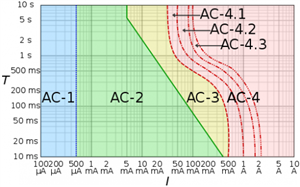

AJJewsbury:
There's a famous graph )from IEC 60479) of how long a (typical) human body can withstand various currents for (for various different results, from nothing (AC-1) to a slight tingle (AC-2) right up to various probabilities of death (AC-4)):
To make that useful for protecting a human from electric shock you need to make a few assumptions - e.g. the resistance of the body between contact points (e.g. hand and foot) but if you assume 1kΩ you can then read milliamps on the graph for volts across the body. In a TN system with a fault of neglible impedance between L and PE you'd get a voltage of about half the nominal voltage at the point of the fault (half dropped along the line conductor, half along the PE) - looking up about 115V (115mA on the graph) and staying out of the AC-4 regions should give you a time of about 400ms (or 0.4s if you prefer).
For TT systems the PE part of the loop (via the customer's electrode) has a much higher resistance than the line conductor, so we can't assume a touch voltage as low as half line voltage - indeed in worst cases it could be almost the full line voltage - 230V say - so looking up 230mA should give you a result closer to 0.2s.
(I just pulled that above image randonly from the internet - there do seem to be a few different versions about that differ slightly (but sometimes significantly) in the details - so don't get too worried if things don't seems to line up precisely.)
- Andy.
Where did you get that colour graph if it is not a rude question as the one in 60479 is B&W
What about the 5s disconnection time where did that come from?
We're about to take you to the IET registration website. Don't worry though, you'll be sent straight back to the community after completing the registration.
Continue to the IET registration site